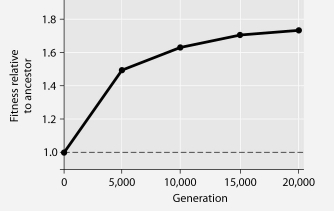The following questions refer to Figure 27.1.
In this eight-year experiment, 12 populations of E. coli, each begun from a single cell, were grown in low-glucose conditions for 20,000 generations. Each culture was introduced to fresh growth medium every 24 hours. Occasionally, samples were removed from the populations, and their fitness in low-glucose conditions was tested against that of members sampled from the ancestral (common ancestor) E. coli population.

Figure 27.1
-Which of the following, if it occurs in the absence of any other type of adaptation listed here, is least reasonable in terms of promoting bacterial survival over evolutionary time in a low-glucose environment?
Definitions:
Q11: The thermoacidophile Sulfolobus acidocaldarius lacks peptidoglycan, but
Q22: How might identical and obviously duplicated gene
Q25: A high degree of endemism is most
Q29: The existence of evolutionary trends, such as
Q39: Pores on the leaf surface that function
Q48: Regarding these sequence homology data, the principle
Q53: A proficient engineer can easily design skeletal
Q57: The predatory fish rely on visual cues
Q99: Molybdenum has an atomic number of 42.
Q100: Each of the eight ascospores present at